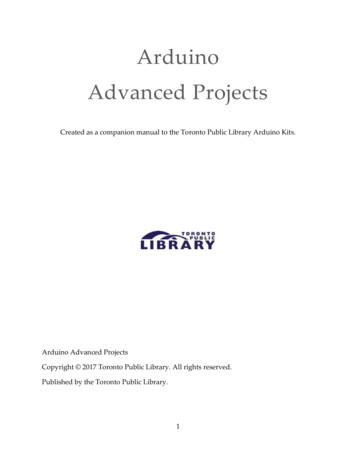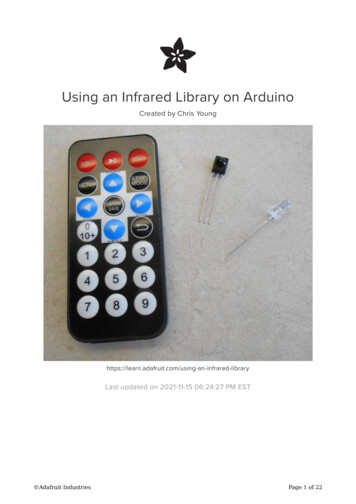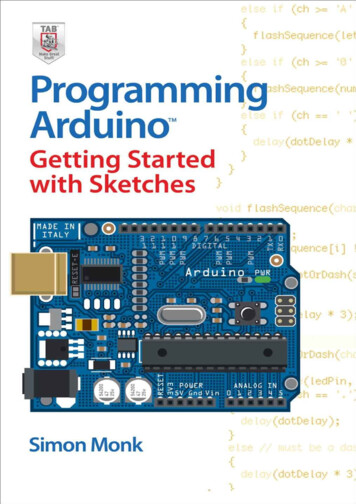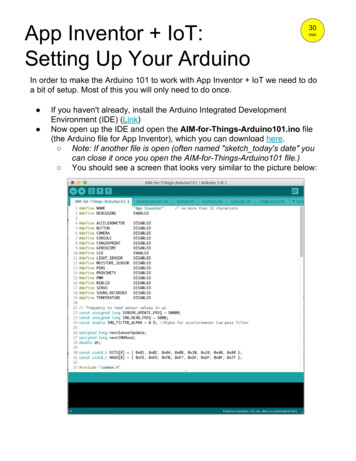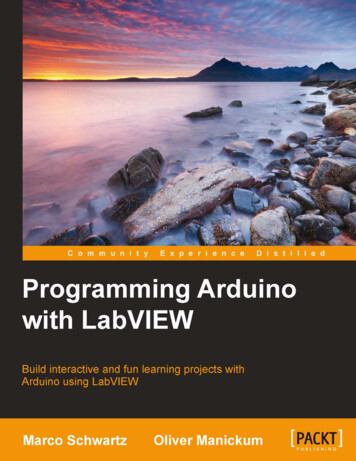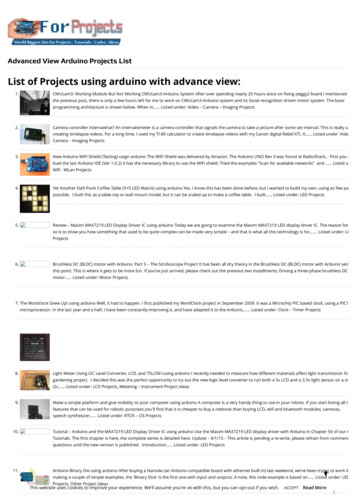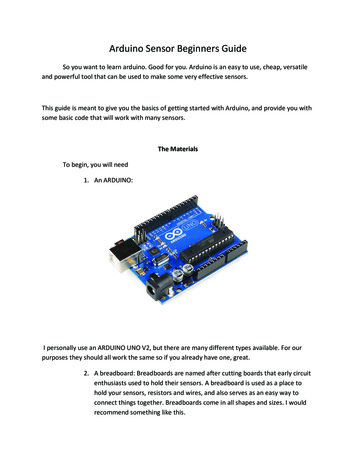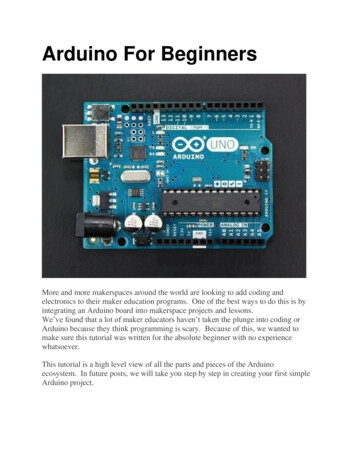
Transcription
Arduino For BeginnersLearn about Arduino and the Arduino UNO and how y ou can integrate this board into y our makerspace and coding program. Make in teractive makerspace projects while learning to co de and problem solve.More and more makerspaces around the world are looking to add coding andelectronics to their maker education programs. One of the best ways to do this is byintegrating an Arduino board into makerspace projects and lessons.We’ve found that a lot of maker educators haven’t taken the plunge into coding orArduino because they think programming is scary. Because of this, we wanted tomake sure this tutorial was written for the absolute beginner with no experiencewhatsoever.This tutorial is a high level view of all the parts and pieces of the Arduinoecosystem. In future posts, we will take you step by step in creating your first simpleArduino project.
What Is Arduino?Arduino is an open source programmable circuit board that can be integrated into awide variety of makerspace projects both simple and complex. This board containsa microcontroller which is able to be programmed to sense and control objects in thephysical world. By responding to sensors and inputs, the Arduino is able to interactwith a large array of outputs such as LEDs, motors and displays. Because of it’sflexibility and low cost, Arduino has become a very popular choice for makers andmakerspaces looking to create interactive hardware projects.Arduino was introduced back in 2005 in Italy by Massimo Banzi as a way for nonengineers to have access to a low cost, simple tool for creating hardwareprojects. Since the board is open-source, it is released under a Creative Commonslicense which allows anyone to produce their own board. If you search the web, youwill find there are hundreds of Arduino compatible clones and variations availablebut the only official boards have Arduino in it’s name.In the next section, we’re going to discuss a few of the Arduino boards available andhow they differ from each other.
Types of Arduino BoardsArduino is a great platform for prototyping projects and inventions but can beconfusing when having to choose the right board. If you’re brand new to this, youmight have always thought that there was just one “Arduino” board and that’s it. Inreality, there are many variations of the official Arduino boards and then there arehundreds more from competitors who offer clones. But don’t worry, we’re going toshow you which one to start with later on in this tutorial.Below are a few examples of the different types of Arduino boards out there. Theboards with the name Arduino on them are the official boards but there are also a lotof really great clones on the market as well. One of the best reasons to buy a clone isthe fact they are generally less expensive than their officialcounterpart. Adafruit and Sparkfun for example, sell variations of the Arduino boardswhich cost less but still have the same quality of the originals. One word of caution,be careful when buying boards from companies you don’t know.Image credit – Sparkfun.comAnother factor to consider when choosing a board is the type of project you arelooking to do. For example, if you want to create a wearable electronic project, you
might want to consider the LilyPad board from Sparkfun. The LilyPad is designed tobe easily sewn into e-textiles and wearable projects. If your project has a small formfactor, you might want to use the Arduino Pro Mini which has a very small footprintcompared to other boards. Check out Sparkfun’s Arduino Comparison Guide for abreakdown and comparison of the top boards out there.Next, we’re going to focus on our favorite Arduino board which we recommendbeginners start with.Arduino UnoOne of the most popular Arduino boards out there is the Arduino Uno. While it wasnot actually the first board to be released, it remains to be the most actively used andmost widely documented on the market. Because of its extreme popularity, theArduino Uno has a ton of project tutorials and forums around the web that can helpyou get started or out of a jam. We’re big fans of the Uno because of it’s greatfeatures and ease of use.
Board BreakdownHere are the components that make up an Arduino board and what each of theirfunctions are.1. Reset Button – This will restart any code that is loaded to the Arduino board2. AREF – Stands for “Analog Reference” and is used to set an external referencevoltage3. Ground Pin – There are a few ground pins on the Arduino and they all work thesame4. Digital Input/Output – Pins 0-13 can be used for digital input or output5. PWM – The pins marked with the ( ) symbol can simulate analog output6. USB Connection – Used for powering up your Arduino and uploading sketches7. TX/RX – Transmit and receive data indication LEDs8. ATmega Microcontroller – This is the brains and is where the programs arestored9. Power LED Indicator – This LED lights up anytime the board is plugged in apower source10. Voltage Regulator – This controls the amount of voltage going into the Arduinoboard11. DC Power Barrel Jack – This is used for powering your Arduino with a powersupply12. 3.3V Pin – This pin supplies 3.3 volts of power to your projects13. 5V Pin – This pin supplies 5 volts of power to your projects14. Ground Pins – There are a few ground pins on the Arduino and they all work thesame15. Analog Pins – These pins can read the signal from an analog sensor and convertit to digital
Arduino Power SupplyThe Arduino Uno needs a power source in order for it to operate and can be poweredin a variety of ways. You can do what most people do and connect the board directlyto your computer via a USB cable. If you want your project to be mobile, considerusing a 9V battery pack to give it juice. The last method would be to use a 9V ACpower supply.
Arduino BreadboardAnother very important item when working with Arduino is a solderlessbreadboard. This device allows you to prototype your Arduino project without havingto permanently solder the circuit together. Using a breadboard allows you to createtemporary prototypes and experiment with different circuit designs. Inside the holes(tie points) of the plastic housing, are metal clips which are connected to each other bystrips of conductive material.On a side note, the breadboard is not powered on its own and needs power brought toit from the Arduino board using jumper wires. These wires are also used to form thecircuit by connecting resistors, switches and other components together.
Here is a visual of what a completed Arduino circuit looks like when connected to abreadboard.
How To Program ArduinoOnce the circuit has been created on the breadboard, you’ll need to upload theprogram (known as a sketch) to the Arduino. The sketch is a set of instructions thattells the board what functions it needs to perform. An Arduino board can only holdand perform one sketch at a time. The software used to create Arduino sketches iscalled the IDE which stands for Integrated Development Environment. The softwareis free to download and can be found at https://www.arduino.cc/en/Main/Software
Every Arduino sketch has two main parts to the program:void setup() – Sets things up that have to be done once and then don’t happen again.void loop() – Contains the instructions that get repeated over and over until the boardis turned off.How Everything Works TogetherCheck out our quick Arduino video to see how a breadboard, Arduino, jumper wiresand the sketch work together to perform a function. In this video, we use amomentary push button switch to blink an LED.Arduino ProjectsYou may be wondering what an Arduino board can do besides blink an LED. Beloware some example projects which help to showcase how truly amazing this board isand the capabilities of it. If you’re looking for more project ideas, check out sitessuch as Instructables or Make Magazine which are loaded with helpful tutorials.Arduino Light Following Robot – Instructables
Arduino Drone That Follows You – InstructablesLED Cube w/ Arduino Uno – Instructables
Control A Doorlock Using Arduino and Bluetooth – MAKE Magazine
Tools NeededNext we will help to highlight some of the most common tools you will need whenworking with Arduino projects. Needle-nose PliersWire StrippersPrecision Screwdriver SetFlush CuttersFine Tip Straight TweezersDigital MultimeterSoldering IronPanavise JrSolder Sucker
Arduino ShieldsIf you want to add a very specific functionality to your Arduino, you will need to usea shield. Arduino shields plug into the top of the Arduino board and can addcapabilities such as WiFi, Bluetooth, GPS and much more. There are literallyhundreds of shields to choose from and here are a few examples. WiFi ShieldLCD ShieldGPS Logger ShieldMP3 Music Maker ShieldEthernet ShieldMotor/Stepper/Servo ShieldGPS Shield Plugged into Arduino Uno – Sparkfun.com
Arduino SensorsIf you want your Arduino to sense the world around it, you will need to add asensor. There are a wide range of sensors to choose from and they each have aspecific purpose. Below you will find some of the commonly used sensors inprojects. Distance Ranging SensorPIR Motion SensorLight SensorDegree of Flex SensorPressure SensorProximity SensorAcceleration SensorSound Detecting SensorRGB and Gesture SensorHumidity and Temperature SensorExamples of Arduino Sensors
Electronics RetailersBelow are some of our favorite places we tend to go when we need makerspacematerials or electronic components. AdafruitSparkfunMakershedRadio ShackJamecoDigikeyMCM ElectronicsMouserConclusionThis may be the end of this tutorial, but it’s just the beginning of your journeyworking with Arduino. Stay tuned for future posts and guides on Arduino.Makerspaces.com
Board Breakdown Here are the components that make up an Arduino board and what each of their functions are. 1. Reset Button – This will restart any code that is loaded to the Arduino board 2. AREF – Stands for “Analog Reference” and is used to set an external reference voltage 3. Ground Pin – There a




